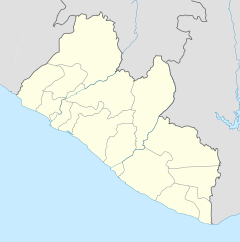The Monrovia Church massacre, also referred to as the St. Peter's Lutheran Church massacre, was the worst single atrocity of the First Liberian Civil War. Approximately 600 people were killed at the church, on 14th Street, in the Sinkor district of Monrovia on 29 July 1990. The massacre was carried out by approximately 30 government soldiers loyal to President Samuel Doe. The perpetrators were of Doe's Krahn tribe while most of the victims were from the Gio and Mano tribes, which were in support of the rebels.
| Monrovia Church massacre | |
|---|---|
| Part of the First Liberian Civil War | |
| Location | Sinkor, Monrovia, Liberia |
| Coordinates | 06°17′30″N 10°46′48″W / 6.29167°N 10.78000°W |
| Date | 29 July 1990 |
| Target | Civilian population |
Attack type | Massacre |
| Weapons | Machine guns, machetes |
| Deaths | ~600 |
| Perpetrators | Armed Forces of Liberia |
Background
editThe First Liberian Civil War lasted from 1989 until 1997. By mid-1990, two rival factions of rebel fighters advanced on the Liberian capital Monrovia and President Samuel Doe was hiding out in his executive mansion near the seaside.[1][2][3]
At night, government soldiers patrolled the streets of those parts of Monrovia still under government control in search for people from Nimba County, the area the rebellion had started in, beating and killing men and engaging in looting. In search for safety, approximately 2,000 people[2] had taken refuge in the St. Peter's Lutheran Church.[1]
Massacre
editApproximately 30 government soldiers[2] climbed over the wall of the church yard on the night of 29 July and carried out the massacre, shooting and hacking to death men, women and children, indiscriminate of age. Of those targeted, only a small number of children survived, hiding under the bodies of adults.[1] The perpetrators of the massacre were from Samuel Doe's Krahn tribe, while most of the victims were from the Gio and Mano tribes, which were in support of the rebels.[2]
An American missionary, Bette McCrandall, listened to the attack from a church compound nearby.[1]
Aftermath
editAmong the first people arriving at the scene of the massacre the following day was a doctor from Guinea who discovered, as the only sign of life, a crying baby. She had to walk over the dead bodies to reach the child and, after picking it up, saw other small children rise from their hiding places.[1]
The massacre, the worst single atrocity of the First Liberian Civil War,[4] resulted in neighbouring countries sending an armed intervention force, under the leadership of the Economic Community of West African States.[1]
While the Liberian embassy in Washington denied involvement of government soldiers in the massacre, the US government confirmed their involvement and initially estimated the number of victims as between 200 and 300.[2]
One of the two rival rebel leaders, Prince Johnson, the other being Charles Taylor,[3] requested that the United States intervene, but it declined to send in the 2,000 Marines stationed off shore.[2] The US deployed Marines in August 1990 as part of Operation Sharp Edge, but only to protect and evacuate American citizens.[5]
United Nations Secretary General Javier Pérez de Cuéllar stated he was horrified by the massacre and requested the protection of civilians in the country.[2]
Former Armed Forces of Liberia officer Boi Bleeju Boi stated in 2008 that he was convinced that the massacre was carried out by government soldiers as it would have been impossible for any rebel force to enter the area, carry out the massacre and retreat without notice of the Army. He also believed that the lack of investigation of the massacre by the Army pointed towards its involvement.[6]
St. Peter's Lutheran Church was rebuilt at the cost of US$1 million (~$1.9 million in 2023) and re-consecrated in August 1993.[7]
Prosecution
editThe decades after the massacre saw no attempt at holding anybody accountable. In 2017 four survivors of the massacre sued a former colonel of the Liberian Special Anti-Terrorist Unit, Moses Thomas, who now lived in Pennsylvania. He denies all involvement of himself or his unit in the massacre. Campaigners hope that winning the civil suit will cause his temporary protected status in the United States to be revoked, and could possibly cause him to be deported to Liberia where, as of 2018, nobody has been tried for the massacres committed during the civil war.[1][8]
References
edit- ^ a b c d e f g "Liberian church massacre survivors seek US justice". BBC News. 12 February 2018. Retrieved 14 December 2018.
- ^ a b c d e f g "Liberia Troops Accused Of Massacre in Church". The New York Times. 31 July 1990. Retrieved 14 December 2018.
- ^ a b "Hundreds Die in Massacre by Liberian Troops : Civil war: As many as 600 refugees are killed in a church. Survivors say the soldiers were President Doe's". Los Angeles Times. 31 July 1990. Retrieved 14 December 2018.
- ^ Davis, Abednego (6 August 2018). "'Lutheran Church Massacre is Liberia's Worst Atrocity'". Liberian Observer. Retrieved 16 December 2018.
- ^ "Operation Sharp Edge". GlobalSecurity.org. Retrieved 15 December 2018.
- ^ Kpargoi, James Jr. (14 October 2008). "AFL Soldiers Committed Lutheran Church Massacre... 'Gen. Boi' At TRC". The Liberian Journal. Retrieved 16 December 2018.
- ^ "Thousand remember St. Peter's Lutheran massacre". United Press International. 15 August 1993. Retrieved 15 December 2018.
- ^ Fabricius, Peter (22 February 2018). "Lutheran Church Massacre: The Long Arm of the Law reaches a suspected Liberian war criminal in Philadelphia". Daily Maverick. Retrieved 16 December 2018.
